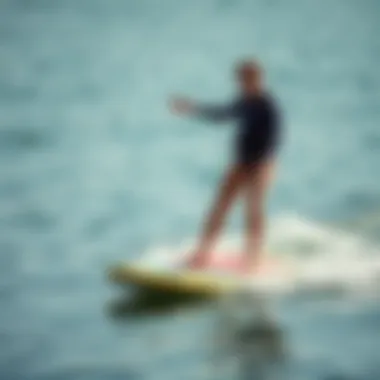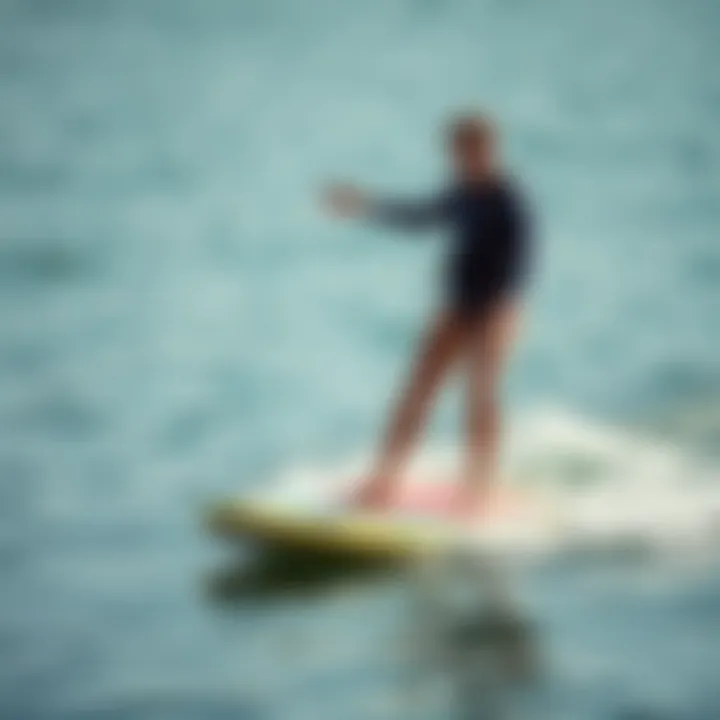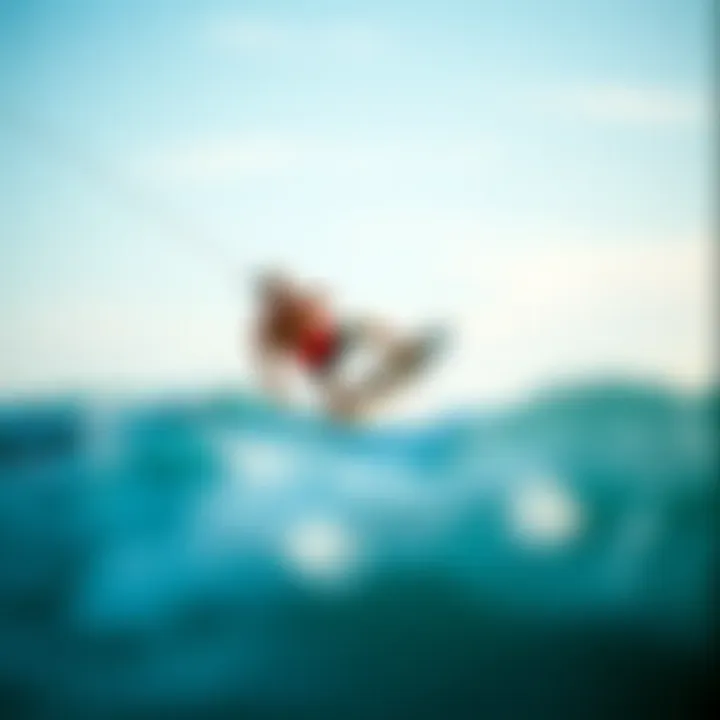Choosing the Right Board Length for Watersports


Intro
Selecting the right board length is often seen as a daunting task, which is hardly surprising given the array of factors involved. Whether you’re a seasoned pro cutting through waves or a newcomer testing the waters, the board you choose can make or break your experience. What many might overlook is that the ideal board length isn’t just about personal preference; it’s a fine balance between personal style, individual skill, and the specific conditions of the water where you’ll ride.
In this guide, we will delve into the nuances of board selection, breaking it down into digestible pieces. Skills vary widely among athletes, and the impact of environmental conditions can shift from one session to another. It’s not merely a matter of grabbing the flashiest new equipment—understanding the subtleties can lead to an enriched experience on the water. We’ll dissect how this selection process can enhance both performance and enjoyment.
Our journey through determining the right board length will encompass insights from experts in the field, review the latest trends in watersports, and offer recommendations for both budding enthusiasts and those who’ve already forged their path in more advanced arenas.
Let’s plunge in.
Prologue to Board Length Considerations
Choosing the right board length is not just a minor detail; it’s akin to selecting the right tool for the job. The board length plays a pivotal role in how effectively one can maneuver, maintain balance, and ride the waves or smooth waters. For any watersport enthusiast—be it surfing, paddleboarding, or kayaking—a well-fitted board can be the difference between a smooth glide and a rocky ride.
Understanding board length involves grasping its basic concept, how it relates to individual performance, and the subtleties that come into play based on differing factors. Each athlete's unique physique, skill level, and preferred riding style demand careful consideration when pinpointing the ideal length for their board. Let’s dive deeper into defining board length, followed by the significance that making the right choice holds for performance and safety on the water.
Defining Board Length
Board length refers to the distance from the tip of the nose to the tail of the board. It's important because this dimension significantly affects the board's buoyancy, stability, and overall performance in various conditions. Typically, longer boards offer more stability and better performance in larger waves, while shorter boards provide increased maneuverability and responsiveness, suitable for tricks and fast-paced riding.
The measurement can vary widely across different types of watersports. A traditional longboard used in surfing is usually 9 feet or longer, while a skateboard-style board might be considerably shorter, around 5 to 6 feet. In paddleboarding, longer boards can enhance tracking and speed, while shorter ones are often more manageable and easier to turn. Therefore, defining your activity is the first step toward understanding which board dimensions are pertinent.
Significance of Choosing the Right Length
The significance of selecting the appropriate board length cannot be overstated. Using a board that is either too long or too short can adversely affect performance. For instance, a novice rider might struggle to achieve balance on a board that is overly long, while an experienced surfer might feel limited on a board that's too short, restricting their ability to harness speed or execute complex maneuvers.
"The right board length enhances not only proficiency but also enjoyment and safety on the water."
Benefits of a proper board length choice include:
- Improved Stability: A well-suited length can significantly increase stability, ensuring that riders can maintain their footing while navigating challenging aquatic environments.
- Enhanced Maneuverability: Correctly selected lengths can provide more confidence in turning and riding waves, matching the rider's instincts, whether they’re cranking a sharp corner or nosediving into a powerful wave.
- Overall Comfort: Finding a board that aligns with both physical proportions and personal riding style fosters a seamless experience. Comfort translates into longer, more fulfilling sessions on the water.
In summary, understanding board length is fundamental. It’s about more than just picking a number; it touches every aspect of your performance. Each choice you make holds the potential to elevate your watersport pursuits, leading you to enjoy every splash with confidence and excitement.
Skill Level and Its Impact on Board Selection
Choosing the right board length is not a one-size-fits-all affair. A rider’s skill level plays a significant role in determining which board to set sail on. Each level of expertise comes with its unique set of needs and demands. Let's break down how skill level can shape the decisions you make regarding your watersport equipment.
Beginner Considerations
When you’re just dipping your toes into the world of watersports, the right board length can greatly affect your learning curve. Beginners often find stability to be a crucial aspect in picking a board. Here are some simple guidelines for those just starting out:
- Longer Boards for Stability: A longer board generally provides better balance and stability. This means that balancing on a longer paddleboard or surfboard can feel more manageable as you practice your skills.
- Width Matters: Wider boards offer increased surface area, which again translates to better stability. This additional support is often comforting for new riders.
- Soft Edges: Selecting boards with softer edges can assist in reducing the chances of falls; they are usually more forgiving, allowing beginners to gain confidence.
So, when selecting a board, consider seeking assistance from instructors or experienced riders. They can often recommend a suitable length tailored to your height and weight. The goal at this stage isn’t just to ride, but to enjoy the learning process while ensuring safety.
Intermediate and Advanced Riders
As you progress in your skills, your requirements shift dramatically. For those at the intermediate or advanced levels, the focus may revolve around performance, speed, and maneuverability. Here are some points to keep in mind:
- Shorter Boards for Maneuverability: Intermediate and advanced riders often prefer shorter boards. These allow for quicker turns and tricks, making them ideal for experienced surfers and paddleboarders.
- Custom Lengths: Riders who know their style may experiment with custom lengths for specific conditions. While general guidelines are helpful, personal preference and experimentation can lead to discovering what suits you best.
- Adjusting to Conditions: The right board length in advanced stages may also depend on the environmental conditions. For instance, choppy waters might call for a different size compared to smooth surf.
As your skills develop, embracing a fluid method could pay off more than strict adherence to standards. Regular feedback from fellow riders or even a coach can be invaluable, leading to not only better performance but also more satisfying sessions on the water.
"The journey from beginner to advanced isn’t just about the skills you gain, but also the equipment you choose to help push your limits."
Overall, understanding the nuances between beginner and advanced board lengths is a vital step in optimizing your enjoyment and performance in watersports. No longer just about learning to float or ride, it’s about carving your path—and that path starts with selecting the right board.
Types of Watersports and Corresponding Board Lengths
When it comes to the world of watersports, understanding the various board lengths for different activities can make all the difference in performance and enjoyment. Each sport has its unique requirements, and the type of board you use can directly influence how well you ride the waves or glide across the water. Selecting an appropriate board length is not merely a matter of convention; it’s about enhancing your experience and optimizing your capabilities on the water.


Surfing Board Length Preferences
Surfboards come in various shapes and sizes, and their length is crucial in zoning in on your surfing style and the types of waves you're tackling. Generally,
- Shortboards (around 5 to 6 feet) are typically favored by more experienced surfers who thrive on maneuverability and speed.
- Funboards or hybrids (about 6 to 8 feet) cater to those at an intermediate level, offering a blend of agility and stability. They serve to generate speed in smaller surf while still allowing for some trickery.
- Longboards (exceeding 8 feet) are excellent for beginners or those who prioritize stability and a leisurely ride. These boards provide ample paddle power and can catch waves easily, which is especially beneficial for newcomers.
Choosing the right board length for surfing is not a one-size-fits-all approach. It takes into account personal height, weight, and the local surf conditions. For instance, if you are hankering down for a session at a big wave beach, a longer board might prove to be your best mate.
Paddleboard Length Variations
Stand-up paddleboarding (SUP) has gained traction for its versatility; hence, paddleboard lengths vary significantly. The dimensions of paddleboards often hinge on their purpose, whether it be racing, leisure paddling, or even surf-focused rides. Consider the following:
- All-Around Boards: Generally sit between 10 to 12 feet, suitable for relaxed paddling on flat waters as well as some maneuvering through small waves. Ideal for recreational users who dabble in a bit of everything.
- Race Boards: Can stretch anywhere from 12 to over 14 feet, designed for speed in competitive environments. The longer length enhances glide, making them perfect for serious paddlers.
- Surf Boards: These boards measured between 8 and 10 feet imbue a shorter design to steer them easily through waves. The lightweight build allows riders to catch surf more efficiently.
Factors such as rider experience and intended use play into these paddleboard lengths and can really shape one's relationship with the water. Not to mention, stability and navigation become pivotal depending on the length chosen.
Kayaking and Its Board Dimensions
While kayaking might not directly correlate with traditional board lengths, the principles of selecting a kayak share a similar foundation. Kayak lengths can sway between 8 to over 16 feet depending on usage:
- Recreational Kayaks: Typically hover around 9 to 12 feet—perfect for leisurely paddlers looking to enjoy calm currents or small lakes. Their shorter lengths also promote maneuverability.
- Touring Kayaks: Anything longer than 12 feet caters to those who wish to embark on lengthy journeys. They are designed to track straight and are built for sustained performance.
- Whitewater Kayaks: Usually shorter, around 6 to 9 feet, these lend themselves to sharp turns and quick responses, essential for navigating rapids.
The right kayak length should correlate with the type of waters you are navigating. For instance, a longer kayak on still waters can enhance speed, while a shorter one boosts agility through turbulent streams.
Choosing the right board length can propel your experience and performance in watersports. It’s not just about having a good time; it’s about tailoring your gear to your unique needs.
Personal Factors Influencing Board Length Choice
When it comes to selecting the appropriate board length for your watersport adventures, personal factors play a significant role. Understanding how individual characteristics affect your choice can lead to a far better experience on the water. With the right length tailored to your needs, you're set up to enhance performance and enjoyment. Let's delve into the two essential aspects of this topic: height and weight considerations, as well as riding style and preferences.
Height and Weight Considerations
One's height and weight are fundamental in determining the ideal board length. The board must provide the right balance between stability and maneuverability.
- Height impacts leverage and control. Taller riders might require longer boards to comfortably stand without feeling cramped, while shorter individuals could find longer boards unwieldy.
- Weight affects buoyancy and the board's performance on water. Heavier individuals might benefit from a board with increased volume to float better and maintain stability, while lighter riders may opt for a smaller board that allows for greater agility.
For instance, if an athlete weighs around 200 pounds and is 6 feet tall, a board length of around 9 feet might be suitable for paddleboarding. Alternatively, a rider who stands at 5 foot 5 and weighs 140 pounds may do best with a board close to 8 feet. Ultimately, these metrics set the stage for achieving optimal performance tailored to body dimensions.
Riding Style and Preferences
Riding style greatly influences board selection. Every rider has unique needs shaped by the way they approach their sport, which in turn affects the desired board length.
- Casual riders seeking relaxation typically prefer longer boards that offer more stability, essential for smoother rides.
- Performance-oriented athletes, however, might lean towards shorter boards for quicker turns and more dynamic maneuvers, allowing them to showcase their skills effectively.
Furthermore, reflecting on whether you enjoy cruising, racing, or freestyle activities can direct your choice. For example, a recreational paddleboarder might prioritize comfort, opting for a board longer than others. In contrast, a competitive surfer likely favors a shorter board for agility and responsiveness.
"Your board should feel like an extension of yourself—find your perfect length to ride your way!"
Environmental Conditions and Their Role in Board Length Selection
Selecting the right board length isn't solely about personal preferences or riding style; it heavily relies on the environment where you’re going to ride. Understanding how various environmental factors impact board performance is an essential aspect for anyone engaging with watersports. From the waves crashing against the shoreline to the weather on that crisp morning, these conditions dictate not only how well the board performs but also how comfortable and confident a rider will feel while participating.
Wave Size and Water Conditions
The size of the waves and the overall water conditions play a pivotal role in determining board length. For instance, when surfers are in the thick of towering waves, they need boards that can easily slice through the water while providing stability. A shorter board can be beneficial in this scenario, allowing for quicker maneuvers, whereas a longer board provides more surface area and stability for smaller or choppy waves.
- Bigger Waves: For larger swells, many riders prefer boards that are slightly longer. This added length offers extra buoyancy, keeps the tail locker deeper, and helps maintain control when riding the wave's face.
- Choppy Water: Conversely, in choppy conditions, shorter boards can minimize drag and make navigation easier. Here, the ability to quickly shift weight becomes critical for maintaining balance.
Riders must also consider freshwater vs. saltwater conditions. Saltwater often creates more buoyancy, and thus a board length that works in fresh water might feel entirely different in a saltwater environment.
Weather Implications on Performance
Weather does not just cloud the sky or bring a chill to the air; it plays a crucial role in your overall performance while riding. Wind speed, for example, can have a significant effect on how a board performs in the water. Strong winds might require a longer board to help stabilize during cuts and turns.


- Sunny, Calm Days: On days with optimal weather conditions, a rider might choose a more responsive, shorter board to take advantage of the perfect conditions.
- Windy Days: When wind picks up speed, opting for a longer board can mean better control, allowing riders to still enjoy the water without being tossed around.
Moreover, temperature can also play a pivotal role. Colder weather conditions may cause boards made of different materials to behave differently compared to those warmer conditions. For instance, some materials can harden in colder temperatures, affecting flexibility and overall performance.
"The right board length isn’t just about you; it’s about understanding how nature interacts with your equipment. In the ever-changing world of water sports, tuning into those environmental whispers could be the difference between a great day out and a challenging one.”
In summary, when determining the ideal board length for watersports, it’s critical to factor in both the size of waves and prevailing weather conditions. This not only enhances the rider's experience but also plays a vital role in safety and performance on the water.
Board Length Charts and Guidelines
Choosing the ideal board length isn’t just a matter of preference; it’s a blend of science and art. Board length charts and guidelines serve as a crucial backbone for anyone looking to enhance their watersport experience. Understanding these can make a significant difference in performance, stability, and comfort on the water.
Take note that charts are not one-size-fits-all solutions. They provide general guidance based on common practices and standards in the industry. Riders need to interpret these recommendations considering personal factors and specific conditions. Here’s what you need to keep in mind:
- Understand Your Discipline: Each watersport has its unique demands. This means the ideal board length varies greatly from surfing to paddleboarding or kayaking.
- Weight and Height Considerations: Most charts include general guidelines based on body weight and height. An efficient match here ensures better buoyancy and control.
- Riding Style: The way you ride—be it aggressive carving or laid-back cruising—can dictate the length you should choose. A chart might guide you, but your riding style should steer the final decision.
"The right board length can feel like an extension of your body, while the wrong one can feel like fighting against an anchor."
Standard Length Recommendations by Discipline
Looking for standard length recommendations is like looking up a recipe before you start cooking: you can still tweak it to suit your taste, but the basic elements must be in place. Every sport has its sweet spot to ensure you get the best performance out of your board.
Surfing
In surfing, board lengths commonly range from 5'6" to 7'6" for short boards, while longboards traditionally span 9' and above. Referring to charts can provide a starting point, but seasoned surfers often adjust based on wave size and maneuverability preferences.
Paddleboarding
For paddleboarding, the standard length ranges between 10' to 12'6". This variation often correlates with the type of board; racing boards are typically longer to enhance speed, while those for leisure can be shorter for better maneuverability.
Kayaking
In kayaking, board length recommendations fall between 10' to 14'. Longer kayaks often yield better tracking, while shorter boats are easier to handle in tight spaces. The chart will guide you, yet water conditions and your intended purpose should weigh heavily on your choice.
Custom Length Options for Specific Needs
While standard guidelines are useful, there are times when adjusting to your specific needs becomes necessary, particularly for avid riders or those with unique body types. Custom boards have gained popularity, allowing riders to fine-tune their board lengths for optimized comfort and performance.
Tailoring to Personal Requirements
When considering a custom board, think about the following factors:
- Skill Level: Advanced riders may prefer longer boards for added speed and stability in open waters, while beginners might find shorter boards easier to control.
- Body Proportions: Tall riders may find standard boards too short, affecting their balance. A board customized to one’s dimensions can maximize comfort.
- Targeted Conditions: If you plan to tackle bigger waves or navigate thick backwaters, custom lengths can offer the competitive edge you seek.
Collaborating with Experts
Engaging with local shapers or artisans can also uncover insights on how to refine your board’s length. They offer feedback based on their experiences, which may include knowledge of regional water characteristics that standard charts fail to address.
Testing and Experimenting with Board Lengths
When it comes to watersports, the mantra of "trial and error" often rings true, especially regarding board length. Testing different lengths plays a vital role in helping riders find the perfect match that aligns with their skill, environment, and personal preferences. It’s not merely a case of picking the shiniest board off the shelf; it’s about understanding the nuances that come with every choice you make.
This section dives into practical ways to experiment with board lengths while shedding light on the significant benefits that come along with it.
How to Test Different Lengths
Testing different board lengths isn’t just about hopping on a new surfboard and calling it a day. It's akin to trying on shoes before a long hike—what fits one person might lead another to blisters and miserable results. Here are some steps to effectively test out your options:
- Rent Before You Commit: Many shops offer rental options. Try out various lengths before investing in your own gear. Don't shy away from asking to take a few different boards for a spin.
- Find a Buddy: If you have a friend who’s already into these water activities, borrow their boards. This can give you realistic feedback based on actual experiences.
- Experiment in Different Conditions: Take the same board length and try it in varied conditions—flat water, choppy waves, and small swells each present distinctive challenges. You may find that a board you loved in calm waters behaves differently when the sea gets rough.
- Keep Notes: Document your feelings while riding each board length. Was it easier to paddle? Did you catch more waves? By jotting down your experiences, you'll have something to refer back to when making decisions.
- Consult with Instructors or Coaches: Getting insight from professionals can provide guidance tailored to your abilities. Their eye for detail may point out things you wouldn’t have considered.
Feedback from Experienced Riders
Learning from seasoned riders can significantly elevate your understanding of board lengths. Their experiences often reveal invaluable insights and perspective. Here are a few things to consider when gathering feedback:


- Ask Key Questions: Inquire about their favorite board lengths for specific conditions or styles. How do they approach length adjustments based on skills?
- Listen to the Rationale: Pay attention to the reasons behind their preferences. Sometimes, it could be a minor quirk that fits their style perfectly.
- Community Discussions: Forums and social media groups are treasure troves of information. Engage in conversations on platforms like Reddit or specialized Facebook groups, gaining insights from various riders' experiences.
- Local Meetups or Events: Participating in local water sports events can be an excellent opportunity to ask questions directly while building connections in the community.
"Asking around can save you time, effort, and money; you’ll likely hear about boards that perfectly fit your needs from those who’ve laid the groundwork long before you arrived."
Ultimately, being open to feedback and willing to experiment will guide you to the end of your search for the perfect board length. It’s about understanding that what works wonders for one could fall flat for another, necessitating a personalized approach for true satisfaction in your watersport endeavors.
- For more insights on this topic, check out resources like Britannica or explore watersport forums on sites like Facebook.
The journey to discovering that ideal board length is as rewarding as the activities themselves.
Common Mistakes in Board Length Selection
Choosing the right board length involves more than just a glance at charts; it's a blend of personal preference, experience, and environmental factors. Mistakes in this selection can lead to diminished performance and, more importantly, a lack of enjoyment on the water. Understanding these common pitfalls can significantly enhance your overall experience and success in your chosen sport.
Overlooking Individual Needs
One of the biggest oversights in selecting a board length is failing to consider personal needs. Every rider is unique, and what works for one person may not suit another. Individual factors such as body weight, height, and even riding style play critical roles in determining the ideal board length. For instance, a lighter rider may find a shorter board easier to maneuver, whereas a heavier individual might prefer additional length for stability.
Moreover, mindset matters too. Enthusiasts who prioritize speed often overlook how their size alters board performance. If you're a beginner, leaning towards a board that’s overly long could hinder your ability to gain balance and confidence. Thus, understanding one’s own requirements forms the backbone of effective board selection.
- Ask yourself:
- What’s my experience level?
- How do I plan to use the board?
- What specific situations will I encounter?
Every rider should prioritize personal needs above all else, as failing to do so might result in a frustrating, sub-par experience.
Ignoring the Importance of Flexibility
Another common blunder comes from disregarding flexibility in board selection. Boards aren’t a one-size-fits-all, and many watersport pursuits demand varying degrees of adaptability based on changing conditions and personal growth. For many, sticking too rigidly to a particular board length can stunt progress.
Flexibility can manifest in different ways:
- Multiple Boards: Investing in more than one board can allow for adjustments based on conditions or skill growth.
- Length Adjustments: Some boards offer adjustable lengths. Learning how to utilize these features can radically transform your performance.
Ignoring how your needs might evolve can create barriers to improvement. A seasoned kayaker, for instance, might begin with a shorter board for easier navigation but later transition to a longer board for enhanced speed. This evolution in choice should be celebrated, rather than hindered by a static approach.
"Flexibility allows for an organic development of skills and adaptation to weather, waves, and personal growth."
Engaging with your board choice means being open to adjustments and changes, ensuring that your equipment works alongside your evolving enjoyment of the water.
Understanding these mistakes and remaining mindful of personal needs and flexibility will help you optimize your board length selection. It’s a beautiful journey—don’t limit yourself with rigid choices!
Closure: Making an Informed Decision
Choosing the right board length is more than just a number; it’s a crucial factor that can significantly impact your performance and enjoyment in various watersports. The decision-making process involves a careful evaluation of multiple factors including your personal attributes, environmental conditions, and specific riding styles. This article has aimed to break down these complex considerations into digestible pieces, so that you're well-equipped to make a sound decision that aligns with your individual needs.
Understanding the individual characteristics of board lengths enables you to tailor your equipment to get the most out of every session on the water. The key elements to consider range from your height and weight to your skill level and style, as well as the specific water conditions you often encounter. This holistic approach ensures that you're not merely choosing a board based on a trend or general advice; rather, you're making an informed choice based on nuanced and relevant factors that apply directly to you.
In the grand scheme of things, selecting the appropriate board length contributes to optimized performance. It enhances your control, balance, and overall enjoyment, making every moment on the water count. Don’t underestimate how these factors can transform your experience.
"Your choice in board length can be the difference between a smooth ride and a frustrating one."
The goal, therefore, is to synthesize all the insights and guidelines presented throughout this article into an actionable plan during your board selection process. Taking the time to comprehensively evaluate all elements can lead to a fulfilling and rewarding watersport experience.
Summarizing Key Takeaways
- Skill Level: Understand how your personal skill level influences the type of board length that best suits your needs. Beginners may benefit from longer boards for stability, while advanced riders might prefer shorter options for maneuverability.
- Riding Style: Identify your primary riding style, whether it’s cruising, trick riding, or racing, as this will heavily impact your choice as well.
- Environmental Factors: Consider the typical water conditions you face; these can drastically alter board performance.
- Experimental Approach: Use trial and error to discover what truly works for you. Don’t hesitate to switch up your board lengths until you find what feels right.
Ultimately, capturing these key points ensures that anyone engaged in watersports has a solid foundation to base their decisions upon.
Encouragement for Informed Trial and Error
Don't shy away from testing different board lengths, as experience is an excellent teacher. Just like learning to ride a bike, initially trying different lengths can lead to some awkward moments, but these experiments are invaluable.
Embrace failure as part of the process. For instance, you might find after a few sessions that the longer board was great at first but too cumbersome in choppy conditions. Maybe the shorter one proves to be zippy but lacks stability when handling waves. Each experience will inform your future choices, bringing you closer to that perfect setup.
Engage with other riders, either in local groups or online forums. Their stories and suggestions can help guide your experimentation. A community of experienced riders can provide real-world insights that trim down your learning curve significantly.
In summary, keep an open mind, be flexible, and let your journey in finding the ideal board length be as enjoyable as the watersports you engage in.







